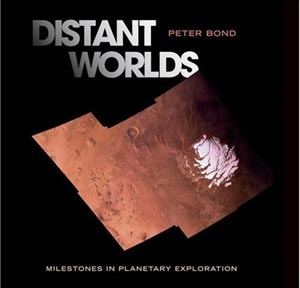Review: Distant Worldsby Jeff Foust
|
| As an introduction and overview to our current understanding of the solar system, Distant Worlds is a serviceable book. |
Bond eschews thematic or literary approaches to his review of the solar system, instead providing a straightforward tour of the major bodies orbiting the Sun. After an introductory chapter reviewing the history of humanity’s understanding of the solar system and the various techniques used to study it, from Galileo’s telescopes four centuries ago to present-day spacecraft, Bond devotes one chapter to each planet in the solar system, in order of distance from the Sun, from Mercury to Pluto (the chapter that would be used for Earth instead covers the Moon.) There’s also a chapter about asteroids, tucked in between Mars and Jupiter just like the main belt of asteroids orbiting the Sun, and one at the end covering comets. Each chapter has a similar structure: a history of the exploration of that world, by telescope and spacecraft, with a discussion of the discoveries made by those scientists and spacecraft that have furthered our knowledge of that world, along with any plans for future missions. The end of the book includes several appendices, including lists of spacecraft sent to each planet and general physical data about each planet and its moons.
As an introduction and overview to our current understanding of the solar system, Distant Worlds is a serviceable book. Bond provides a readable, accurate review of our knowledge of each planet, as well as comets and asteroids. However, there’s not much of a “big picture” view of the significance of this knowledge in understanding our place in the solar system (or galaxy, or universe), or to society in general. Distant Worlds makes no attempt to tackle these issues; the book even lacks a concluding chapter, going from a section about Europe’s Rosetta comet mission at the end of the comets chapter right into the appendices.
One other unfortunate aspect of Distant Worlds is that the book feels a little dated. While that’s to be expected of any book about an active field of scientific endeavor, the book—which has a 2007 copyright date—isn’t as up-to-date as one might expect. In the chapter about Pluto, for example, there’s no mention of the recent IAU vote that demoted the world to the ranks of “dwarf planets” (although Distant Worlds is not the only recent book to have missed that development; see our review of Is Pluto a Planet? from last April). Worse, the book is very vague about the launch of NASA’s New Horizons mission to Pluto: Bond never explicitly states that the mission was launched in January 2006, only saying that it had to launch that month in order to reach Pluto in 2015. One explanation: the author’s preface is dated September 2005, suggesting that the book was written before the launch (not to mention other planetary discoveries in the last year), but was only more recently published.
Despite those issues, Distant Worlds is a good review of our (more-or-less) current understanding of the solar system, particularly for those people not terribly familiar with anything more than the basics. Certainly it will be superseded in the years to come by other books, not because of its quality but because of the continuing pace of discoveries that advance our knowledge of our nearest neighbors in the cosmos.
